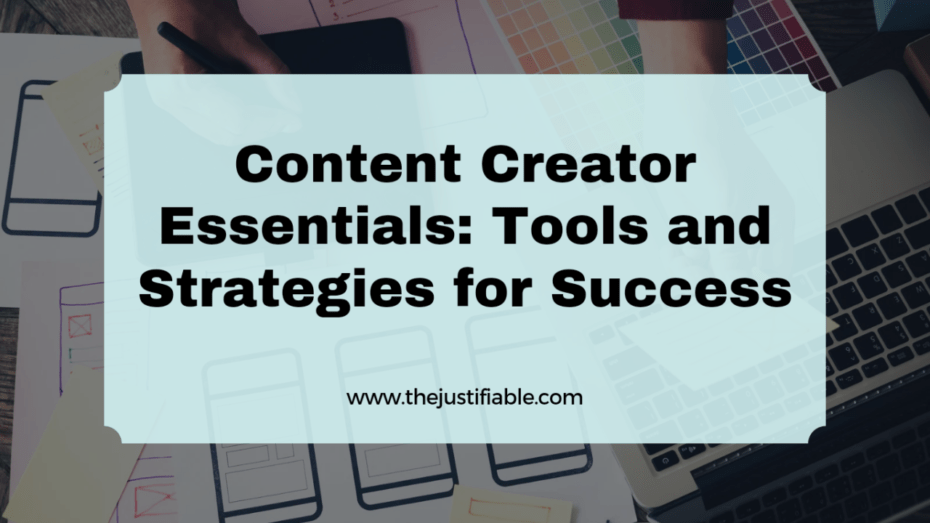Table of Contents
In the vast landscape of the digital world, the term “content creator” has emerged as a pivotal role. With platforms ranging from YouTube to TikTok, from blogs to podcasts, there’s a myriad of spaces for creatives to share their visions.
But who exactly is a modern content creator, and why are originality and authenticity the buzzwords of the decade? Let’s delve in.
Defining The Role of a content creator in today’s digital age
A content creator is an individual or team responsible for ideating, producing, and sharing digital content tailored to specific audiences. Gone are the days where content was primarily about writing articles; today, it encompasses videos, infographics, podcasts, livestreams, and much more.
In essence, a content creator crafts stories, shares experiences, or imparts knowledge in digital formats tailored to the ever-evolving preferences of online audiences. Platforms like Instagram, YouTube, and TikTok have democratized content creation.
No longer is it exclusive to big corporations or media houses; anyone with a smartphone, a voice, and a vision can become a content creator. With this democratization, though, comes saturation. This brings us to the undeniable importance of standing out, and two key factors play a role here: originality and authenticity.
The importance of originality and authenticity
In a world overflowing with content, originality is the cornerstone of visibility. It’s not just about creating something new; it’s about adding a unique perspective, a fresh voice, or a novel approach to existing topics. It’s the “why” behind users choosing to engage with one content creator over another amidst the multitude of options available.
However, originality alone isn’t enough. In today’s digital age, where consumers are increasingly skeptical of polished marketing tactics, authenticity has risen to the fore. Authenticity is about being genuine, staying true to one’s values, and building trust. For the modern content creator, it’s the authentic connections they build with their audience that fosters loyalty and long-term engagement.
When a content creator’s work is both original and authentic, it resonates. It speaks to audiences on a personal level, paving the way for deeper connections, meaningful conversations, and a community built on trust. And in the digital age, where fleeting attention spans are the norm, such connections are invaluable.
Essential Tools Every Content Creator Should Have
In the dynamic realm of content creation, having the right tools can make all the difference.
Whether you’re starting out or are a seasoned content creator, equipping yourself with the right hardware, software, and understanding of online platforms can be the distinguishing factor between producing content that is merely good and content that is exceptional.
Here, we’ll delve deep into these essential tools that every content creator should have in their arsenal.
Hardware essentials: cameras, microphones, and lighting
No matter your niche or medium, quality content creation starts with top-notch hardware:
- Cameras: For vloggers, photographers, and any content creator who prioritizes visuals, investing in a high-quality camera is paramount. Today’s market offers a range of options, from DSLRs to mirrorless models, each with its own strengths. However, don’t underestimate the power of the latest smartphones; they can capture stunning visuals, making content creation more accessible than ever.
- Microphones: Whether you’re podcasting, creating video content, or livestreaming, clear audio is essential. USB microphones offer portability and ease, while XLR mics provide professional-grade audio. Lavalier mics, meanwhile, are perfect for on-the-go interviews or outdoor sessions.
- Lighting: A content creator can have the best camera and mic, but without proper lighting, the quality can suffer. Softbox lights, ring lights, or even natural lighting can significantly elevate the visual appeal of your content, making it more engaging for your audience.
Software solutions: editing programs, graphic design, and planning tools
Once you’ve got your hardware sorted, the next step is refining your content and making it shine:
- Editing Programs: For videographers, tools like Adobe Premiere Pro or Final Cut Pro are staples in the industry. For audio-centric creators, programs such as Audacity or Adobe Audition can polish your sound to perfection.
- Graphic Design: Every content creator needs compelling visuals, be it for thumbnails, social media posts, or blog graphics. Adobe Photoshop and Illustrator are industry standards, but Canva offers a more user-friendly interface for those less versed in graphic design.
- Planning Tools: Content creation isn’t just about production; it’s about strategy. Tools like Trello, Asana, or even Google Calendar can help content creators plan their content schedule, ensuring consistency and timeliness.
Online platforms: understanding where to share your content for maximum reach
It’s not enough just to create content; understanding where and how to share it is equally crucial:
- Social Media Platforms: Whether it’s Instagram for visual content, YouTube for videos, or Twitter for bite-sized updates, knowing where your audience spends their time can amplify your reach. Every platform has its nuances, and mastering these can significantly boost engagement.
- Blogging Platforms: For written content, platforms like WordPress, Medium, or Substack can be invaluable. These platforms allow content creators to share long-form content, reach niche communities, and even monetize their work.
- Specialized Platforms: Depending on your niche, platforms like Behance for designers, SoundCloud for musicians, or Twitch for gamers can offer specialized audiences looking for content just like yours.
Content Creation Strategies for Success
Success in the content creation arena isn’t just about having the right tools; it’s also about adopting effective strategies.
Every content creator, regardless of their niche or medium, needs a blend of careful planning, deep understanding of their audience, and compelling storytelling to truly make a mark. Below, we’ll unpack these essential strategies that can propel any content creator to success.
Content planning and calendar creation
Every successful journey begins with a well-laid plan, and content creation is no exception:
- Strategic Vision: Begin by setting clear objectives. What do you aim to achieve with your content? Whether it’s brand awareness, community building, or sales, defining your goals will shape your content strategy.
- Consistency is Key: One of the golden rules for content creators is maintaining consistency. Whether it’s daily, weekly, or monthly, decide on a posting frequency and stick to it. Your audience should know when to expect new content from you.
- Content Calendar Creation: Equip yourself with a content calendar. This tool will help you visualize and plan your content ahead of time, allowing for a more strategic approach. Factor in special dates, holidays, or trending events relevant to your niche, ensuring your content is always timely and resonant.
Understanding your audience and niche
Content that resonates is content that understands:
- Audience Analysis: Dive deep into who your audience is. Using tools like Google Analytics or platform-specific insights, understand their demographics, behaviors, and preferences. This knowledge will inform not just what content you create, but how you present it.
- Niche Mastery: In the vast world of content creation, finding and mastering your niche is vital. Whether you’re focused on sustainable fashion, vegan recipes, or indie gaming, know your niche inside out. This positions you as an authority and helps build trust with your audience.
- Feedback Loop: Always keep the lines of communication open with your audience. Encourage feedback, conduct polls, or host Q&A sessions. This not only fosters community but also offers invaluable insights into what your audience truly wants.
The art of storytelling and content narrative
Stories have the power to captivate, inspire, and engage:
- Finding Your Unique Voice: Every content creator has a unique voice. Find yours and let it shine through your content. It’s this distinct voice that will set you apart from the crowd.
- Crafting a Compelling Narrative: Whether it’s a blog post, a video, or a podcast episode, every piece of content tells a story. Ensure that your narrative has a clear beginning, middle, and end. This structure not only keeps your audience engaged but also ensures your message is effectively conveyed.
- Emotional Resonance: Humans are emotional beings, and content that tugs at the heartstrings often leaves a lasting impact. Infuse your content with emotions — be it humor, inspiration, joy, or even sadness. When your audience feels something, they’re more likely to remember and share your content.
Further Content Creation Strategies for Success
Delving deeper into the vast world of content creation, it becomes evident that the path to success is multi-faceted. Beyond the foundational strategies, several nuanced tactics can be equally transformative for content creators aiming for unparalleled success.
Leveraging Multi-Platform Synergy
- Platform Complementarity: Don’t be confined to just one platform. Use the strengths of one platform to complement weaknesses in another. For instance, teaser videos on Instagram can lead to full-length content on YouTube.
- Repurposing Content: Create once, use multiple times. A long-form YouTube video can be turned into a blog post, multiple short clips for social media, and even a podcast episode. This way, you maximize reach without constant creation.
- Consistent Branding: Ensure that your branding remains consistent across platforms. Your audience should immediately recognize your content, whether it’s a tweet, a TikTok video, or a blog post.
Engaging with Content Trends and Challenges
- Stay Updated: Platforms like TikTok or Instagram often introduce trending challenges or hashtags. Engage with them while ensuring they align with your brand. It can be a way to introduce your content to a broader audience.
- Evergreen vs. Trending: While trends are vital, don’t neglect evergreen content. This type of content remains relevant over time and can consistently drive traffic to your platform.
- Collaborate: Engage in collaborations with fellow content creators. It’s a strategy to tap into their audience base and vice versa. Plus, it brings fresh perspectives to your content.
Data-Driven Decision Making
- Analyze and Iterate: Use analytics tools available on most platforms. Understand which content is working, which isn’t, and why. Use this data to refine your content strategy.
- A/B Testing: Especially useful for content creators who run ads. Test different headlines, visuals, or call-to-actions to see which resonates more with your audience.
- Feedback Incorporation: Beyond just collecting feedback, ensure you act on it. If a significant portion of your audience asks for a particular content type or topic, consider accommodating their requests.
Investing in Continuous Learning
- Upskill: The digital landscape is ever-evolving. Take online courses, attend webinars, or simply stay updated with industry news to keep your content strategies fresh and relevant.
- Networking: Join content creator communities, both online and offline. Sharing experiences and challenges with peers can lead to newfound insights and strategies.
- Seek Mentorship: If possible, find a mentor in the content creation space. Their guidance and experience can be invaluable, helping you avoid pitfalls and capitalize on opportunities faster.
Monetization Methods for the Savvy Content Creator
Monetizing one’s craft is often a pivotal moment in the journey of a content creator. In today’s digital age, multiple avenues are available to turn your content into a consistent revenue stream.
By understanding and implementing the right monetization strategies, a content creator can not only sustain their passion but also transform it into a lucrative venture. Here’s a deep dive into some of the most effective monetization methods available to the modern content creator.
Affiliate marketing: promoting products and earning commissions
- How It Works: At its core, affiliate marketing involves promoting third-party products or services to your audience. Each sale made through a unique link provided to the content creator results in a commission. It’s a win-win: brands get increased sales, and content creators earn a share of the profit.
- Choosing the Right Products: For a content creator, it’s crucial to promote products or services that resonate with their audience and align with their niche. This ensures authenticity and maintains audience trust.
- Maximizing Earnings: Successful affiliate marketing goes beyond merely sharing links. In-depth reviews, tutorials, or even testimonial videos can make promotions more compelling and boost conversions.
Sponsored content: partnering with brands for financial gain
- Building Partnerships: Brands often seek content creators who have an engaged audience that aligns with their target market. Creating content sponsored by a brand can be a direct and substantial source of income. It’s essential, however, for the content creator to disclose such partnerships to maintain transparency.
- Negotiating Terms: While brands might approach with their terms, savvy content creators should be proactive. Understand your content’s value, negotiate rates, and ensure both parties are clear about deliverables and expectations.
- Maintaining Authenticity: While sponsored content is a paid partnership, the content creator’s voice and authenticity should remain intact. It’s this authenticity that made the audience fall in love with the content creator in the first place.
Subscription models and member-only content
- The Rise of Exclusivity: With platforms like Patreon, Substack, and even YouTube’s membership options, content creators can now offer exclusive content to subscribers or members. This creates a steady and predictable revenue stream.
- Offering Value: To encourage viewers to become paying subscribers, a content creator must offer added value. This could be in the form of early access, behind-the-scenes content, exclusive videos, or even tangible perks like merchandise.
- Building a Loyal Community: Subscription models aren’t just about content; they’re about building a tighter-knit community. Engage with members, seek their feedback, and ensure they feel valued. Their continued subscription is not just a testament to the content’s quality but also the sense of belonging the content creator fosters.
Diversifying Income Streams: Beyond the Basics for the Modern Content Creator
While the aforementioned methods are foundational to monetizing content, a forward-thinking content creator knows the importance of diversifying income streams.
A diversified approach not only stabilizes income but also safeguards creators from platform-specific challenges or changes in market trends. Here’s a look at additional monetization methods that every modern content creator should consider.
Digital Products and Online Courses
Expertise into Income: Many content creators possess a wealth of knowledge in specific areas. Transforming this expertise into digital products, such as eBooks, templates, or online courses, can generate significant revenue.
Passive Income Potential: Once created, digital products can be sold an unlimited number of times without additional effort, making it a source of passive income.
Building Authority: Offering courses or informational products further establishes a content creator as an authority in their niche, which can lead to more opportunities and partnerships.
Merchandise and Physical Products
- Brand Expansion: For content creators with a loyal following, launching branded merchandise—from T-shirts to stationery—can be a lucrative endeavor. Fans often want to support creators and showcase their allegiance, and merchandise offers a tangible way to do so.
- Collaborative Ventures: Partnering with artisans or local businesses to create limited-edition products can also be a way to offer something unique to your audience while supporting other small businesses.
- Dropshipping as an Option: For those wary of inventory and logistics, dropshipping offers a way to sell physical products without holding stock, reducing financial risks.
Live Events, Workshops, and Webinars
- Direct Engagement: Hosting live events or workshops, either online or in-person, allows content creators to engage directly with their audience. This offers an immersive experience that many fans are willing to pay for.
- Monetization through Tickets: Charge an entry fee for exclusive content, training sessions, or Q&A segments. The sense of immediacy and intimacy can command higher prices than asynchronous content.
- Sponsorship Opportunities: Live events can also attract sponsors. Partner with brands that align with your content and audience to further boost revenue during these sessions.
Donations and Crowdfunding
- Direct Support: Platforms like Ko-fi or Buy Me a Coffee allow fans to offer one-time donations as a show of support. For content creators who may not have a consistent posting schedule or those just starting, this can be a vital source of income.
- Crowdfunding Campaigns: For bigger projects or ventures, platforms like Kickstarter or Indiegogo can be used to raise funds. By offering backers exclusive perks or products, content creators can secure the necessary funds while also validating the demand for their project.
Evolving with the Trends: Staying Relevant as a Content Creator
In the dynamic digital landscape, relevance is fleeting. What’s trending today might be forgotten tomorrow. For a content creator, it’s not just about capturing the audience’s attention but holding onto it. Staying relevant requires a content creator to be adaptable, receptive, and informed.
Here’s a closer look at how modern content creators can evolve with the trends and stay at the top of their game.
Continuous Learning: The Importance of Upskilling
- Rapidly Changing Digital Tools: New tools and software are being introduced at a breakneck pace. For a content creator, mastering these tools can be a differentiator. Be it a new editing software or a novel content format, upskilling ensures you stay ahead of the curve.
- Industry Insights: Enrolling in online courses, attending workshops, or simply reading industry blogs can provide insights into what’s changing in the content creation realm. This knowledge empowers a content creator to adjust their strategies accordingly.
- Adaptable Skillset: A diverse skill set ensures that a content creator can easily pivot if one content format wanes in popularity. For instance, a blogger might benefit from learning video editing as video content becomes increasingly prevalent.
Engaging with Your Community and Feedback Loops
- Direct Line to Your Audience: Regularly engaging with your community, be it through comments, polls, or Q&A sessions, gives a content creator invaluable insights. Your audience will tell you what they love, what they don’t, and what they want to see next.
- Iterative Content Creation: Use feedback to refine content. If a particular topic or format receives overwhelming support, it might be worth exploring further. Conversely, understanding criticisms can guide improvements.
- Building Trust: A content creator who actively engages and values their community’s feedback fosters trust. An audience is more likely to stay loyal to creators who they feel listen to and value them.
Staying Updated with Platform Algorithms and Changes
- Algorithm Mastery: Every platform, from YouTube to Instagram, has its algorithm that determines content reach. Understanding these algorithms, even at a high level, can be the difference between your content being seen by thousands or getting lost in the digital abyss.
- Adapting to Platform Evolutions: Platforms occasionally introduce major updates or shift their focus. A content creator who is quick to adapt to these changes can capitalize on new features before they become saturated.
- Diversifying Platforms: While it’s essential to master the algorithm of your primary platform, diversifying your content across multiple platforms safeguards against drastic algorithm changes that might adversely impact visibility.
Challenges Faced by Today’s Content Creator and How to Overcome Them
The life of a content creator, though rewarding, comes with its unique set of hurdles. In an era where everyone with a smartphone can become a content creator, navigating the digital space requires resilience, adaptability, and a touch of ingenuity.
Let’s delve into some of the pressing challenges faced by today’s content creator and explore strategies to surmount them.
The Issue of Content Saturation and How to Stand Out
- Understanding the Challenge: Every day, millions of pieces of content are uploaded across various platforms. This deluge can drown even the most exceptional content, making visibility a prime challenge for content creators.
- Carving a Unique Niche: While the digital space is vast, there are still untapped niches or unique perspectives waiting to be explored. As a content creator, finding and owning a specialized niche can significantly reduce competition and increase visibility.
- Quality Over Quantity: Rather than producing content in bulk, focusing on higher quality, well-researched, and original pieces can help in standing out. Your audience will appreciate depth and thoughtfulness.
- Engagement is King: Algorithms on most platforms reward engagement. Actively interacting with your audience, encouraging comments, shares, and likes, can boost your content’s reach and visibility.
Dealing with Burnout and Maintaining Consistent Output
- Recognizing Burnout: Being a content creator can be relentless. The pressure to constantly produce can lead to burnout, characterized by fatigue, reduced creativity, and dwindling motivation.
- Scheduled Breaks: Just as with any job, it’s crucial to schedule regular breaks. These can be daily pauses, weekly off-days, or even longer vacations. Time off can rejuvenate creativity.
- Batch Creation: On inspired days, create content in batches. This reservoir can be a lifesaver during less productive phases, ensuring a steady stream of content even when you’re not actively creating.
- Outsource When Needed: It’s okay to seek help. Whether it’s editing, scriptwriting, or graphic design, sometimes outsourcing certain tasks can lighten the load and prevent burnout.
Protecting Your Content: Understanding Copyrights and Trademarks
- The Digital Theft Dilemma: With the ease of downloading and reposting, content theft is a genuine concern for creators. Intellectual property can be infringed upon, leading to lost revenue and recognition.
- Educate Yourself: Understanding the basics of copyrights and trademarks is the first line of defense. While copyright automatically applies to original content you create, taking formal steps can offer stronger protection.
- Use Watermarks and Digital Signatures: A simple yet effective way to deter unauthorized use of your content is by embedding watermarks or digital signatures. It ensures that even if your content is shared without permission, your brand remains visible.
- Take Legal Action: If your content is stolen and used for profit or gains significant attention, don’t hesitate to seek legal recourse. Platforms also often have mechanisms to report and remove stolen content.
Conclusion: The Future of Content Creation
As we reflect upon the myriad facets of being a content creator in today’s world, it’s paramount to cast our eyes forward and envisage the future of content creation.
The digital domain, with its relentless pace of innovation, promises a horizon replete with possibilities, challenges, and transformative experiences. Here’s what the tomorrow of content creation might look like.
The Ever-evolving Landscape of Digital Content
- Adaptive Algorithms: The algorithms of popular platforms will become even more sophisticated, driven by advancements in artificial intelligence. For the content creator, understanding and harnessing these changes will be vital.
- Audience Autonomy: With the rise of decentralized platforms and web 3.0, the control is increasingly shifting to the audience’s hands. Content creators will need to cultivate deeper, more authentic relationships with their followers.
- Diverse Content Formats: While written blogs, images, and videos dominate today, the future might see a rise in interactive content, live streams, 3D visualizations, and other immersive formats, offering content creators a broader canvas to express their creativity.
The Potential of New Mediums: Virtual Reality, Augmented Reality, and Beyond
- Virtual Reality (VR) Experiences: Beyond gaming, VR offers content creators a chance to craft holistic, immersive experiences. Imagine virtual art galleries, interactive storytelling sessions, or 360° documentaries — the scope is vast and exhilarating.
- Augmented Reality (AR) in Everyday Content: AR, with its blend of the digital and the real, can revolutionize mundane content. From interactive product reviews to AR-driven tutorials, the potential applications are endless and promise to reshape audience engagement.
- New Frontiers with Mixed Reality and Holography: As technologies mature, we might soon see holographic performances, mixed-reality interactive sessions, and more, offering content creators tools that were once the stuff of science fiction.
- Ethical Considerations: As content ventures into these intimate and immersive realms, ethical considerations will gain prominence. Content creators will need to tread with sensitivity, ensuring that their creations respect privacy, mental well-being, and societal norms.
Drawing the curtain on our exploration, one thing is abundantly clear: the journey of a content creator, though rife with challenges, is an odyssey of endless potential and innovation.
As technologies push boundaries, content creators will be at the forefront, chronicling stories, sharing insights, and shaping experiences in ways we can only begin to imagine.
The future of content creation is not just promising; it’s transformative. And for those willing to evolve, adapt, and embrace the new, the sky is truly the limit.






